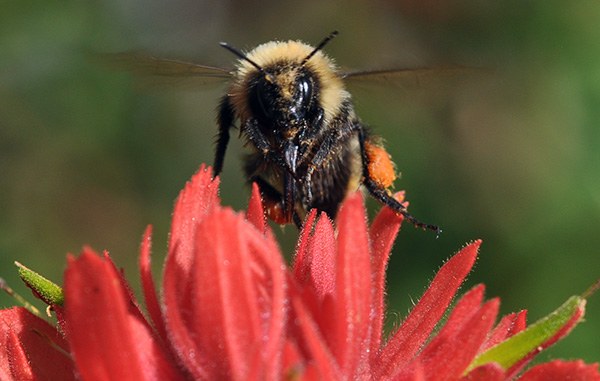
After a long winter, there's nothing more wonderful than seeing the mountains in bloom. It’s that time of year when hikers are returning to the trails, hoping to admire the petals popping up to color our landscapes. Of course, wildflowers wouldn’t be possible without pollinators. But did you know that out of the 28 species of bumble bees found in the Northwest, one in particular is largely responsible for our alpine blooms?
The high country bumble bee
As its name suggests, the high country bumble bee is especially well-suited to mountainous environments. Though most commonly found in Alaska and down the spine of the Rocky Mountains, there are also a few alpine areas in Washington, like the high-elevation plateaus of the Pasayten Wilderness, with the needed resources for these bumble bees to thrive.
Undeterred by rain or snow, the high country bumble bee is one of the first pollinators to kick off spring. Thanks to their large body size and dense, insulating fur, these bees are more equipped to fly at cooler temperatures than many other insects. And on those especially frigid mornings above the tree line, they can even flex their muscles to raise their body temperature by several degrees, the bee equivalent of shivering.
Anticipating spring
The transition from winter to spring initiates a new life cycle for these bees. The majority of last year’s colony will not have survived, but a few fertilized queen bees are preparing to leave hibernation. As the snowline recedes and the alpine wildflowers begin to blossom, the queens emerge to find new nest sites, typically seeking holes in the ground or other pre-existing cavities in the landscape rather than building new hives. Here, they will lay their eggs to produce the upcoming season’s colony.
Alpine adaptations
High country bumble bees have several adaptations that allow them to pollinate a variety of flowers in alpine systems, where the flowering season is short, and the weather can be extreme. With their robust bodies, high country bumble bees are strong enough to carry pollen across far distances – an essential skill when flowers are few and far between in the early season. These bumble bees are also known affectionately as “generalists,” because their tongues have evolved to extract pollen and nectar from many types of flowering plants, not just one species.
Perhaps their most unique adaptation is that these bumble bees can “buzz pollinate.” They are able to vigorously shake a plant until the pollen locked within its flower explodes onto the bee, something only a few types of bees can do. This technique makes it easier to maximize each flower visit so that more nutritious pollen can be brought back to stock the nest. At the same time, some extra pollen will stick to the bee’s furry legs to be deposited at the next stop.
Role in the ecosystem
Most flowering plants rely on pollinators for successful reproduction. Bumble bees are therefore keystone species in many alpine ecosystems across Washington State, meaning that other species in these systems depend on the bees’ success for their survival. Further up the food chain, plant-feeding animals including bears, goats, and elk reap the rewards of the bumble bees’ hard work.
As you delight in the mountains speckled with lupine, aster, and red paintbrush, pause and listen for the buzz of the high country bumble bee. Though hard to spot, they are there every spring, ensuring that nature’s cycle carries on.
This article originally appeared in our Spring 2022 issue of Mountaineer Magazine. To view the original article in magazine form and read more stories from our publication, visit our magazine archive.
 Issy Steckel
Issy Steckel